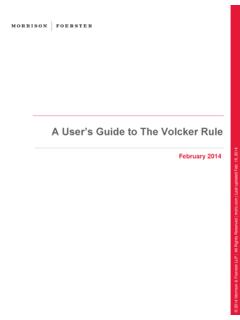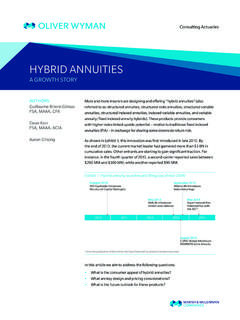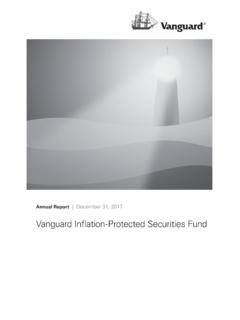Transcription of Hybrid securities: an overview - IFLR.com
1 This article was first published in the Capital Markets multi-jurisdictional guide 2012/13 and is reproduced with the permission of the publisher, Practical Law Company. MULTI-JURISDICTIONAL GUIDE 2012/13 CAPITAL MARKETSA nalysisHybrid securities : an overviewPeter J Green, Thomas A Humphreys, Jeremy C Jennings-Mares and Anna T PinedoMorrison & Foerster history of Hybrid securities may well be divided into two periods: pre-financial crisis and post-financial crisis. Before the crisis, Hybrid issuances were quite significant and product struc-turing efforts resulted in a vast array of Hybrid products.
2 Following the financial crisis, regulators have been focused on enhancing the regulatory capital requirements applicable to financial institutions and ensuring that there is greater transparency regarding financial instruments. Regulatory reform will continue to affect the future of Hybrid chapter provides a brief overview of the principal structuring, legal, tax, regulatory and accounting considerations related to the issuance of Hybrid securities . In particular, it: Provides a general overview of Hybrid securities . Considers some specific examples of Hybrid securities .
3 Examines how Hybrid securities performed during the financial crisis. Outlines the regulatory reform that has been introduced in the wake of the crisis. Considers the emergence of contingent capital instruments and their potential to replace Hybrid securities like trust preferred chapter is a summary and does not purport to be a full dis-cussion of the regulatory and tax issues, which are quite complex and differ jurisdiction by jurisdiction. overview OF Hybrid CAPITAL SECURITIESH ybrid capital securities , or securities that have some equity characteristics and some debt characteristics, have been popu-lar for over a decade.
4 Hybrid securities lie somewhere along the equity-debt continuum, but where exactly, is the subject of great debate, and depends largely on the terms of the instruments as well as the provisions of applicable national laws. In fact, over its life, a Hybrid security may exhibit different proportions of equity-like or debt-like traits, sliding along the section outlines: The format that Hybrid securities can take. The objectives associated with Hybrid capital. Some common types of Hybrid securities . The types of companies that have issued Hybrid securities . The relevant legal framework to consider in structuring a Hybrid capital security.
5 The main bank regulatory requirements and how these differ by jurisdiction. The main tax considerations and how these differ by jurisdiction. The accounting considerations. The ratings considerations. How Hybrid securities can be offered and how and to whom they are usually securities include: Certain classes of preferred stock. Trust preferred securities . Convertible debt securities . Debt securities with principal write-down features. Mandatorily convertible like Hybrid securities because they are considered an attractive, cost-efficient means of raising non-dilutive capital.
6 Hybrid securities are issued by financial institutions, including banks and insurance companies, as well as by corporate issu-ers, which are generally utilities. Hybrid securities often receive favourable treatment by ratings agencies and regulators when they analyse an issuer s capital structure. Many hybrids also pro-vide a lower after-tax cost of capital for issuers compared to com-mon stock. Historically, an issuer and its advisers sought to structure a Hybrid security that: Qualified for favourable equity treatment from rating agencies. Allowed the issuer to make tax-deductible payments.
7 Qualified as Tier 1 capital for bank holding companies (see below, Bank regulatory requirements). The benefits of a Hybrid security depend on its equity-like or debt-like characteristics. From a rating agency and bank reg-ulatory-perspective, more equity-like hybrids generally receive more favourable treatment. From a tax perspective, more debt-like hybrids offer more favourable tax treatment for structuring a Hybrid security, it is helpful to identify the core elements of common equity and the core elements of debt. MULTI-JURISDICTIONAL GUIDE 2012/13 CAPITAL MARKETSINFORMATION about this publication, please visit about Practical Law Company, please visit MOREA nalysisThere are a number of characteristics associated with pure equity , including no maturity, no ongoing payments that could trigger a default if unpaid, and loss absorption for all creditors.
8 For example, common stock has no compulsory or fixed repay-ment obligation or term. In contrast, debt usually has fixed payments and a stated matu-rity. An issuer can elect not to pay dividends on its common stock, but non-payment of principal or interest on a debt security generally constitute an event of default. Common stock provides loss absorption for an issuer, meaning that common stockhold-ers are the last class of security holders to receive distributions in a liquidation. By contrast, debt holders have a right to receive payments before equity stock may entitle the holder to a dividend, subject to declaration by the issuer, and may entitle the holder to some voting rights.
9 As with common stock, non-payment of a preferred stock dividend will not trigger an event of default. However, non-payment may breach a covenant or other contractual undertaking by the issuer. Dividend payments may be cumulative, or non-cumulative. Preferred stock may be convertible, at the option of the issuer or the holder, or mandatorily on the occurrence of certain events. While senior to common stock in liquidation, preferred stock pro-vides some measure of loss absorption, by ranking behind unse-cured debt in terms of priority of payment, in a bankruptcy or other degraded financial situation.
10 Most hybrids contain a deferral feature (optional or mandatory) that permits the issuer to defer the payment of interest or divi-dends. Hybrids also generally are deeply subordinated within the issuer s capital structure. Like an equity security, non-payment of distributions does not result in an event of default. In fact, a Hybrid security holder has limited rights against the issuer for deferred interest payments. In certain structures, deferred interest may be permanently can-celled if certain conditions are satisfied and, as a result, the holder of the Hybrid security may forfeit its claim for deferred interest amounts.












